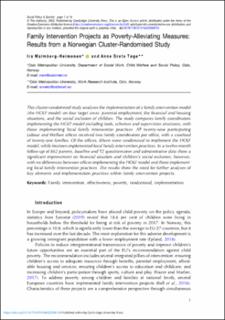| dc.contributor.author | Malmberg-Heimonen, Ira | |
| dc.contributor.author | Tøge, Anne Grete | |
| dc.date.accessioned | 2022-08-23T07:25:09Z | |
| dc.date.available | 2022-08-23T07:25:09Z | |
| dc.date.created | 2022-04-04T08:20:33Z | |
| dc.date.issued | 2022-04-01 | |
| dc.identifier.citation | Social Policy and Society. 2022, . | en_US |
| dc.identifier.issn | 1474-7464 | |
| dc.identifier.uri | https://hdl.handle.net/11250/3012987 | |
| dc.description.abstract | This cluster-randomised study analyses the implementation of a family intervention model (the HOLF model) on four target areas: parental employment, the financial and housing situations, and the social inclusion of children. The study compares family coordinators implementing the HOLF model including tools, schemes and supervision structures, with those implementing local family intervention practices. All twenty-nine participating Labour and Welfare offices received two family coordinators per office, with a caseload of twenty-one families. Of the offices, fifteen were randomised to implement the HOLF model, while fourteen implemented local family intervention practices. In a twelve-month follow-up of 862 parents, baseline and T2 questionnaires and administrative data show a significant improvement on financial situation and children’s social inclusion; however, with no differences between offices implementing the HOLF model and those implementing local family intervention practices. The results show the need for further analyses of key elements and implementation practices within family intervention projects. | en_US |
| dc.description.sponsorship | The Norwegian Labour and Welfare Directorate funded the research project. | en_US |
| dc.language.iso | eng | en_US |
| dc.publisher | Cambridge University Press | en_US |
| dc.relation.ispartofseries | Social Policy and Society; | |
| dc.rights | Navngivelse 4.0 Internasjonal | * |
| dc.rights.uri | http://creativecommons.org/licenses/by/4.0/deed.no | * |
| dc.subject | Family interventions | en_US |
| dc.subject | Effectiveness | en_US |
| dc.subject | Poverty | en_US |
| dc.subject | Randomisation | en_US |
| dc.subject | Implementation | en_US |
| dc.title | Family Intervention Projects as Poverty-Alleviating Measures: Results from a Norwegian Cluster-Randomised Study | en_US |
| dc.type | Peer reviewed | en_US |
| dc.type | Journal article | en_US |
| dc.description.version | publishedVersion | en_US |
| dc.rights.holder | © The Author(s), 2022 | en_US |
| cristin.ispublished | true | |
| cristin.fulltext | original | |
| cristin.qualitycode | 1 | |
| dc.identifier.doi | https://doi.org/10.1017/S1474746422000124 | |
| dc.identifier.cristin | 2014982 | |
| dc.source.journal | Social Policy and Society | en_US |
| dc.source.pagenumber | 1-16 | en_US |

